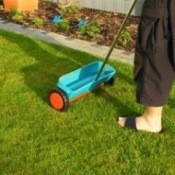 Even though your lawn goes into dormancy during the winter, frigid temperatures, drying winds, and a lack of snow cover can leave it looking tired and ragged once the snow melts. Here are a few simple steps you can take in the spring to get your lawn off to a good start for the growing season.
Even though your lawn goes into dormancy during the winter, frigid temperatures, drying winds, and a lack of snow cover can leave it looking tired and ragged once the snow melts. Here are a few simple steps you can take in the spring to get your lawn off to a good start for the growing season.
If you're not familiar with soil testing, contact your country extension agency for more information. The process is really simple and usually costs somewhere in the neighborhood of $15-$25.
After samples are collected and sent to a lab for analysis, you'll be mailed the results along with recommendations to correct any imbalances. For example, if test results show your soil has a low pH, you'll be advised exactly how much lime per square foot you will need to add to bring it back up to the appropriate levels.
Soil testing is not something that needs to be done annually - results are usually good for 3 to 4 years.
During the course of the winter, most lawns accumulate a variety of small branches, sticks, and leaves. Raking will remove accumulated debris and "massage" dead grass blades out of the soil to help prevent the build-up of thatch. It will also offer you the opportunity to inspect your lawn carefully for problems areas which may have been loosened by the winter's frost heaves.
To install sod:
To seed the area:
This can be especially beneficial on heavy clay or compacted soils, or on areas damaged by extensive periods of wet or dry weather conditions.
There are several ways to aerate your lawn. The more simple methods are wearing spiked "aerating sandals", which poke holes in the ground as you walk, or using a garden fork to poke holes in the ground by hand over a small area.
For larger areas (or lawns in desperate need) "plug" aerators are available, which are designed to be pushed or pulled by hand or attached to the back of a garden tractor. These hollow-tined aerators remove small plugs from the soil as they pass over your lawn, which allows for the greatest penetration of nutrients.
Every now and then, however, your lawn may benefit from a boost of nitrogen. Once the weather warms up, your grass should turn green and start to grow on its own. If it doesn't, rake a thin layer of compost over the entire lawn or apply a complete organic lawn feed.
If after several weeks of warm weather growth continues to be slow, repeat the process again in the summer and consider adding a topdressing to your lawn in the autumn to improve its overall soil structure.
Remember, overfeeding your lawn only encourages excess growth, which results in more work for you (more mowing), so don't do it unless absolutely necessary.